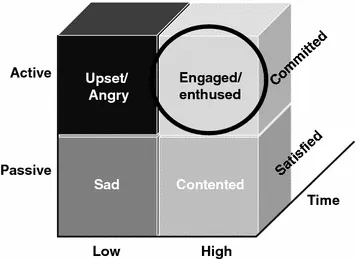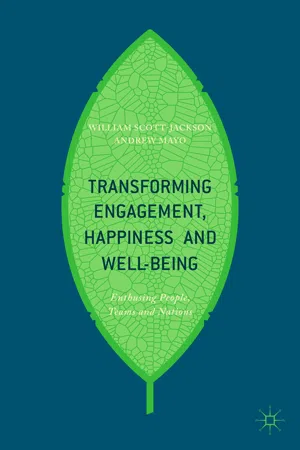1.1 Purpose of the Book
This book aims to provide the tools by which leaders of any organisation, from a small company to a nation state, can maximise the engagement, happiness and well-being of their people.
Leaders of any organisation, whether it be government or a commercial enterprise, have an obligation to not only create, but also maximise, the well-being of those they are responsible for. In addition, high levels of engagement lead to numerous beneficial outcomes , as we shall see. There have been many examples, both at national and at company level, where an absence of properly developed and nurtured well-being has resulted in friction of some sort, sometimes with catastrophic results, and similarly, a lack of engagement leads to significant issues in organisations.
There is also a recent surge in interest in ‘happiness’, another related concept, particularly at country level with Bhutan leading the way in defining Gross Domestic Happiness as the goal of government and countries like the UAE and India appointing Ministers of Happiness to reflect this wider goal. More recently, organisations have also begun to consider employee and customer happiness as a key issue with, for example, Dubai Smart City facilitating happiness projects to make Dubai the happiest city on earth (see Chap. 7). We will suggest that in many cases, what is required is a more active form of happiness (closer to engagement) rather than the relatively passive concepts of happiness and well-being as commonly defined.
Although it is a bit of a truism to say that individuals perform better when they feel good not only about themselves, but about those who control or manage their destiny, it is still surprising how many governments, as well as those involved in commercial leadership/management, forget this very simple rule.
We consider well-being, happiness and engagement to be highly related, with high well-being/happiness contributing to high engagement and vice versa. Unfortunately, theory and practice have tended to be completely separate for all these concepts (with the notable exception of Ulrich and Ulrich (
2010) who also combined research from psychology and management to explore the ‘why of work’), whereas we see them as simply reflecting different dimensions of a common issue. If we think of the
dimensions of active versus
passive , happy versus unhappy and
short term versus long term , then we arrive at Fig.
1.1.
This shows that, for example, the passive short-term high-level state is summed up as ‘contentment’, and indeed, it could be said that many ‘happiness ’ programmes tend to aim for and result in contentment. But for the leaders of organisations and indeed nations, is short-term contentment what we need? We propose that a better goal is on the top right—an active high-level long-term state which we describe as active committed enthusiasm (ACE). This definition allows us to include the excellent research and practice in all these related areas to arrive at one model whose goal is to maximise ACE in employees and citizens.
National and organisational success is much more easily created when there is a general sense of well-being and engagement, and where there are well-being and engagement, there will be success: a virtuous cycle.
We will be examining how leaders, whether at national or organisational level can help to improve both the well-being and engagement of their people in order to create benefits not only to the people themselves, but also to the organisation or nation itself.
Our research has adopted a multidisciplinary perspective to investigate how strategy and policy, individual psychology and management thinking can together not only create but also drive these beneficial outcomes .
Well-being and engagement levels worldwide are extremely low, and this is at least partly because they are both parts of an extremely complex process with a myriad of factors, causal relationships and parameters which need to be considered. So we are going to break down and model this complex process in order to make it easier to assess how individual factors can contribute to ACE.
We have developed a single framework which pulls all of these concepts together and we have named it a
process of active committed enthusiasm (PACE, see Fig.
1.2). We are going to use PACE to distinguish
between causes , constructs and outcomes.
It should also be recognised that individual and organisational contexts and needs change over time, which means that the PACE model is a dynamic tool rather than a one-off fixed model.
Our objective is to provide new ideas, models and clarity to help leaders of any type to maximise individual active committed enthusiasm (ACE). It is not only about measurement , but also, more importantly, the improvement, implementation and development of a truly engaged and happy workforce or citizenry enjoying high levels of well-being.
The principles outlined are valid no matter what the organisation is or its purpose. Whether it is a government or a charity , the principles outlined are exactly the same, but we have written the book from the very specific perspective of the organised body, rather than from the individual’s perspective. In fact, we are looking on how the creation of ACE is necessary in order to contribute to the goals of any organised body of people:
Of course, engagement, happiness and well-being are desirable states in themselves, but specifically, we are going to be looking at achieving high levels of ACE with beneficial outcomes , not just for the individual, but also for the organisation or nation.
It is a self-evident truth that an organisation or a nation exists (or should exist) to serve its population, which means that the achievements of both individuals and the organisation or nation are interdependent in the sense that active committed enthusiasm (ACE) among citizens or employees helps to achieve organisational/national goals and the achievement of organisational/national goals will also create ACE among the people.
We refer to this as bidirectional causality—a chicken and egg situation. In other words, the citizens of the country experience well-being because of that country’s success, and the engagement and well-being of the citizens create that very success in the first place.
Engagement and well-being have been researched and interpreted in many different ways, and as we shall see, other authors have also introduced distinct but related concepts. For instance, Seligman (2012) refers to ‘flourishing’ , whilst Stein and Sadana (2015) see well-being as a product or outcome of health. Macey and Schneider (2008) see the term engagement as referring to ‘psychological states, traits and behaviours, as well as their antecedents and outcomes ’.
The above three examples are just a few of the range of definitions that we have to contend with, so this may be a good point at which to clarify what we mean by well-being and engagement in the context of this book so it is clear where they fit in the PACE.
We see well-being as being a sustained, positive, perceived state of satisfaction with life (often referred to as subjective well-being). This is not to be confused with short-term happiness or even the absence of ‘ill-being’.
Engagement, on the other hand, is an active state of committed enthusiasm towards an organisation, nation or government and its goals.
Engagement resides within the disciplines of management and organisation, and well-being is more a product of national policy and individual psychology.
Nevertheless, and despite the fact that the formal definition of well-being and engagement considers two separate standpoints, there is little doubt that well-being and engagement are highly related to both being identified as causal factors for the other.
We have applied the PACE model to both constructs, and through the model, we aim to demonstrate that the principles which we put forward apply to any sort of organisation, from the smallest group all the way through formal organisations and ultimately nation states.
In recent years, the Sultanate of Oman , for example, has been developing rapidly as a result of a government focus on well-being, from basic provision through to the current focus on intrinsically positive factors.
The Omani experience illustrates quite clearly how any leader can utilise the process model and compare the likely impacts of possible interventions in a systematic and structured manner.
The PACE model is therefore an aid to leaders of organised bodies to achieve national and organisational goals through maximising the engagement and well-being of their citizens and staff. It also provides a useful framework not only for practical application, but also for academic research.




